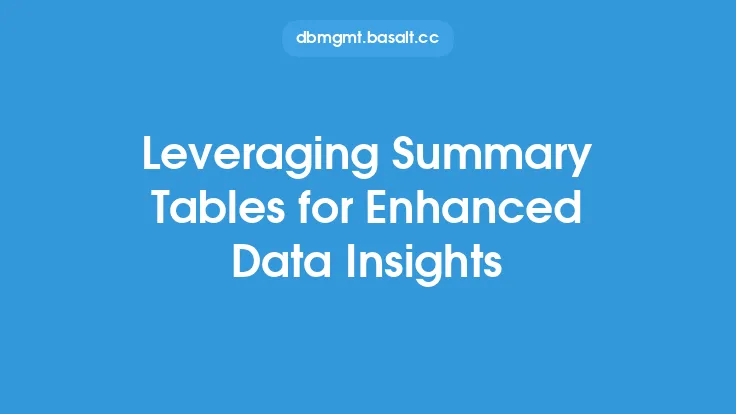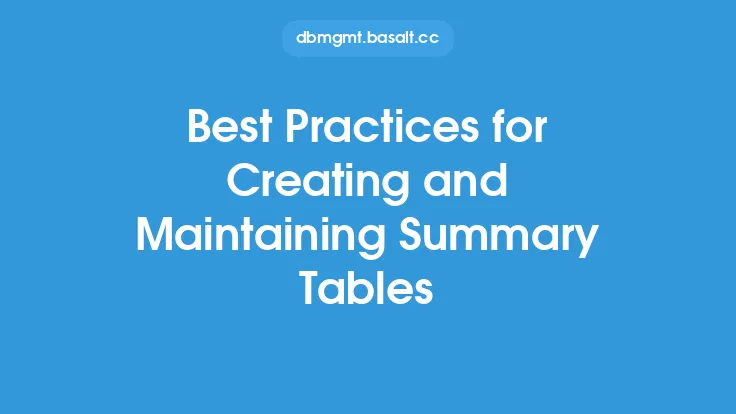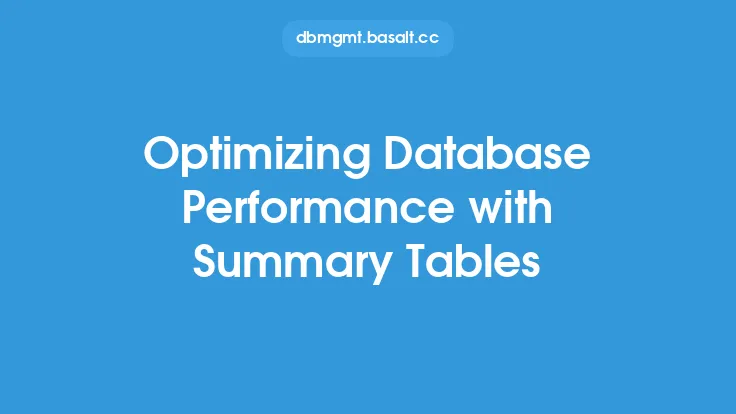When it comes to data analysis, one of the most crucial steps is to present complex data in a clear and concise manner. This is where summary tables come into play. A well-designed summary table can help analysts and stakeholders quickly understand key trends, patterns, and insights from large datasets. In this article, we will delve into the world of designing effective summary tables for data analysis, exploring the principles, best practices, and technical considerations that can make or break a summary table.
Introduction to Summary Tables
Summary tables are pre-computed tables that store aggregated data, typically used to improve query performance and simplify complex data analysis. They can be used to store summarized data, such as totals, averages, and counts, and can be updated periodically to reflect changes in the underlying data. By using summary tables, analysts can avoid having to write complex queries or perform time-consuming calculations, allowing them to focus on higher-level analysis and decision-making.
Principles of Effective Summary Table Design
Designing an effective summary table requires careful consideration of several key principles. First and foremost, the table should be focused on a specific business question or problem. This will help ensure that the table is relevant and useful to stakeholders. Second, the table should be simple and easy to understand, with clear and concise column names and data formats. Third, the table should be optimized for query performance, with appropriate indexing and data partitioning. Finally, the table should be flexible and adaptable, allowing for easy updates and modifications as business needs change.
Choosing the Right Data
One of the most critical decisions when designing a summary table is choosing the right data to include. This involves identifying the key metrics and dimensions that are relevant to the business question or problem. For example, if the goal is to analyze sales trends, the summary table might include columns for sales amount, product category, region, and time period. The data should be aggregated to the appropriate level, such as daily, weekly, or monthly, depending on the business needs. It's also important to consider data quality and integrity, ensuring that the data is accurate, complete, and consistent.
Data Aggregation and Grouping
Data aggregation and grouping are critical components of summary table design. Aggregation involves combining multiple values into a single value, such as calculating the total sales for a given period. Grouping involves dividing the data into categories, such as product category or region. The choice of aggregation and grouping methods will depend on the business question and the characteristics of the data. Common aggregation methods include sum, average, count, and max/min, while common grouping methods include categorization, clustering, and hierarchical grouping.
Indexing and Data Partitioning
To optimize query performance, summary tables should be properly indexed and partitioned. Indexing involves creating a data structure that allows the database to quickly locate specific data values. Partitioning involves dividing the data into smaller, more manageable chunks, such as by date or region. This can improve query performance by reducing the amount of data that needs to be scanned. The choice of indexing and partitioning strategy will depend on the database management system and the characteristics of the data.
Data Refresh and Maintenance
Summary tables require regular refresh and maintenance to ensure that the data remains accurate and up-to-date. This involves updating the table with new data, handling changes to the underlying data, and performing data quality checks. The frequency of refresh will depend on the business needs and the volatility of the data. For example, a summary table used for real-time analytics might need to be updated every hour, while a table used for monthly reporting might only need to be updated once a month.
Technical Considerations
From a technical perspective, designing effective summary tables requires a deep understanding of database design principles, data modeling, and query optimization. The choice of database management system, data storage format, and query language will all impact the design of the summary table. Additionally, considerations such as data security, access control, and auditing will need to be taken into account. The use of data visualization tools and business intelligence software can also enhance the effectiveness of summary tables, allowing analysts to quickly and easily explore and analyze the data.
Best Practices for Summary Table Design
To ensure that summary tables are effective and useful, several best practices should be followed. First, the table should be designed with a clear business question or problem in mind. Second, the table should be simple and easy to understand, with clear and concise column names and data formats. Third, the table should be optimized for query performance, with appropriate indexing and data partitioning. Fourth, the table should be flexible and adaptable, allowing for easy updates and modifications as business needs change. Finally, the table should be regularly refreshed and maintained to ensure that the data remains accurate and up-to-date.
Conclusion
Designing effective summary tables is a critical component of data analysis, allowing analysts and stakeholders to quickly understand key trends, patterns, and insights from large datasets. By following the principles, best practices, and technical considerations outlined in this article, organizations can create summary tables that are simple, flexible, and optimized for query performance. Whether used for real-time analytics, monthly reporting, or strategic decision-making, summary tables can help organizations unlock the full potential of their data, driving business growth and success.





